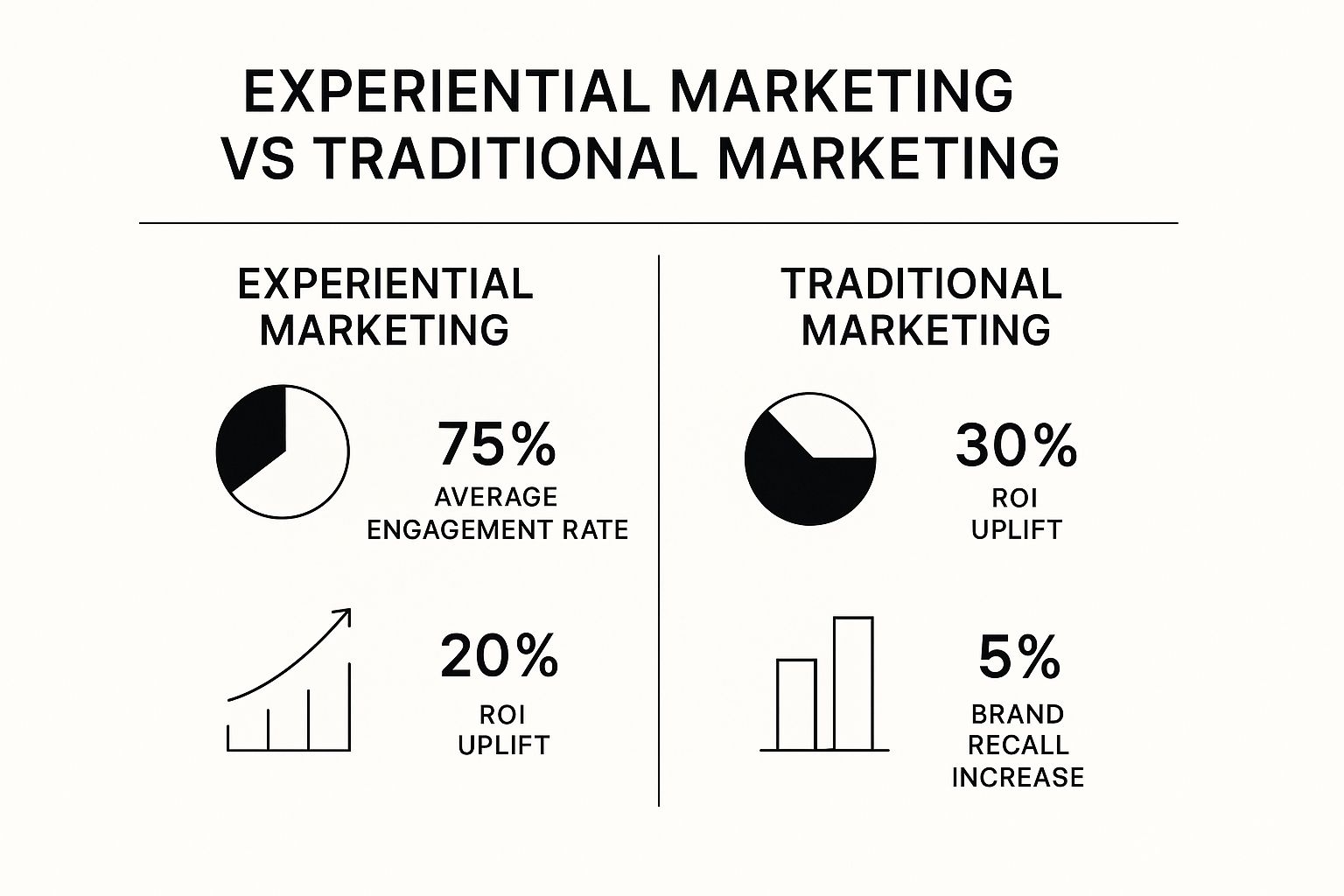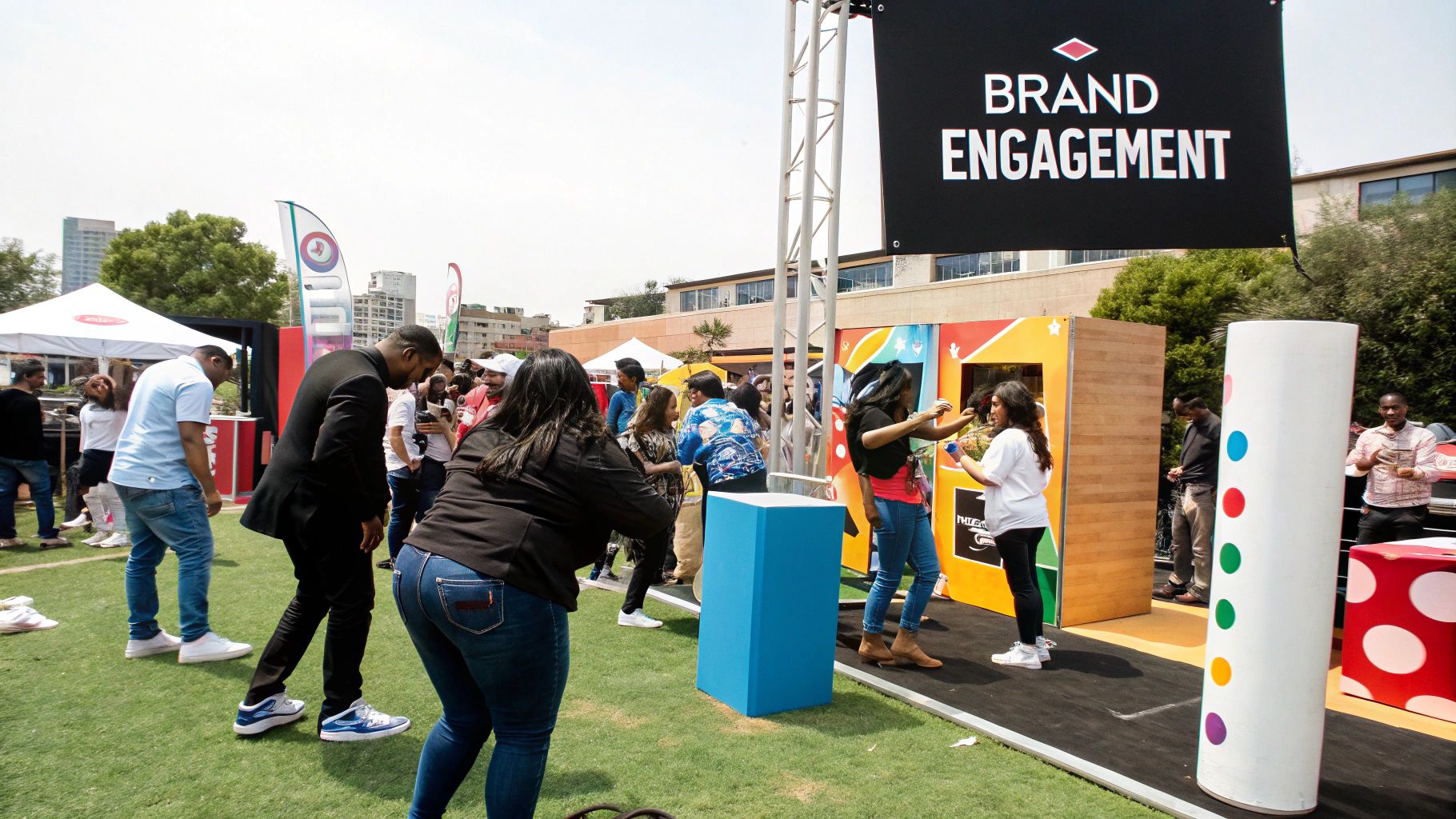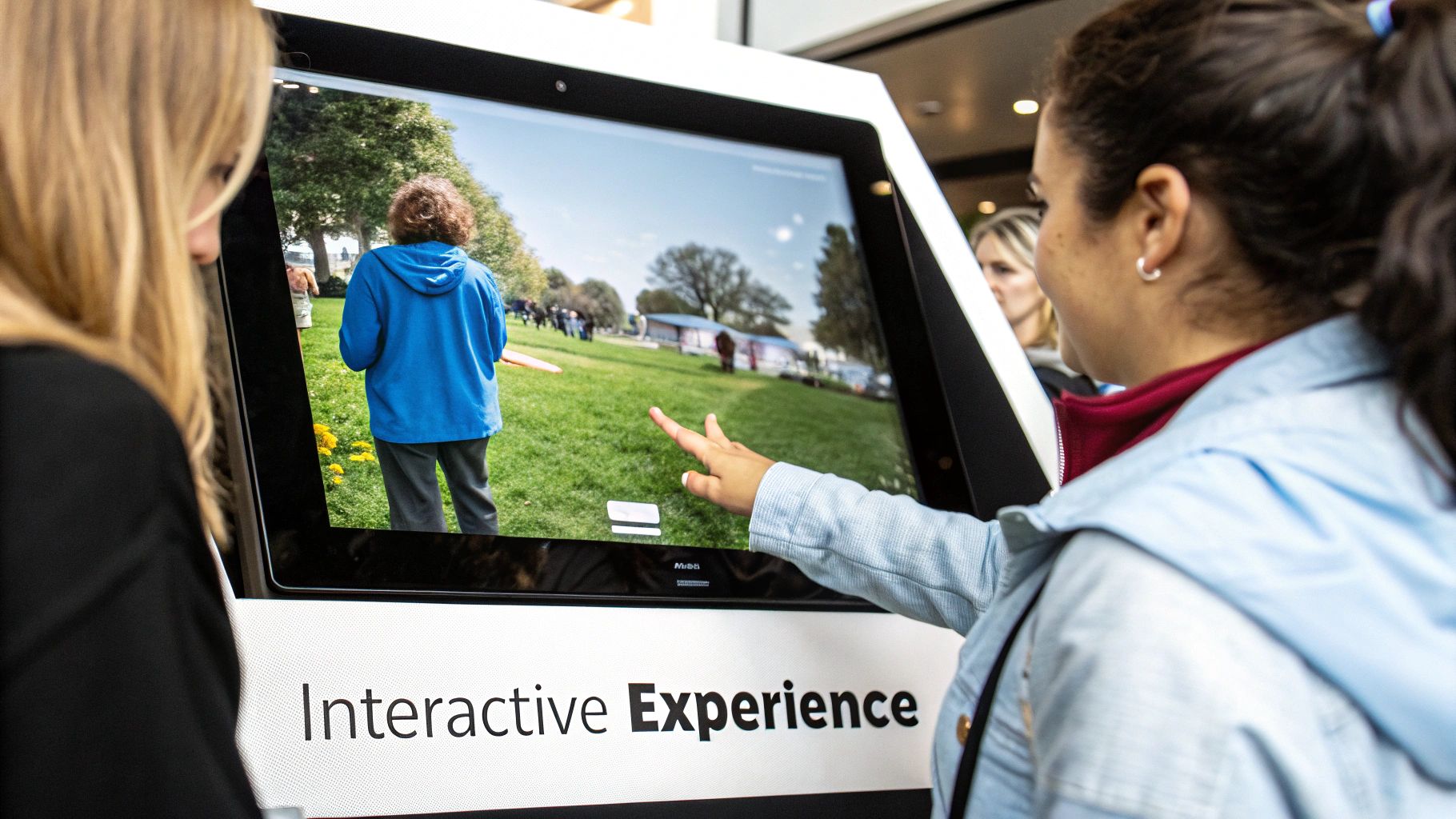Right, let’s ditch the stale PowerPoint slides and forget everything you think you know about advertising. Experiential marketing is all about creating a memorable, interactive brand world that people can literally step into. Instead of just telling someone how great your brand is, you invite them to come and see, touch, and feel it for themselves.
It’s the difference between seeing a trailer for a new Christopher Nolan blockbuster and getting an all-access pass to walk the actual film set. Which one are you going to talk about?
What Is Experiential Marketing?
At its heart, experiential marketing is a strategy that pulls people out of their passive scrolling and turns them into active participants in your brand's story. It's about crafting a genuine, emotional connection by creating a moment they won’t forget. This isn't your standard billboard or banner ad; it's a real, two-way conversation that brings your brand’s personality to life.
Just look at the exclusive pop-up events Rihanna throws for Fenty Beauty. She doesn't just launch a new product; she creates a full-blown cultural moment that people are desperate to be a part of. Fans don't just walk away with a new lipstick; they get to live the brand's edgy, inclusive vibe firsthand, snapping photos and blasting their experience all over social media. That kind of authentic buzz is something money just can't buy.
Moving from Telling to Showing
The ultimate goal here is to create an interaction so powerful that it sticks with someone long after they've gone home. This whole approach is built on a few core ideas:
- Active Participation: The audience has to do something. It could be playing a game, testing a product, or exploring a one-of-a-kind installation. No sitting on the sidelines.
- Multi-Sensory Engagement: The best campaigns hit you on multiple levels. They use sight, sound, touch, and even taste or smell to create a memory that’s impossible to shake.
- Emotional Connection: By creating a fun, exciting, or genuinely meaningful experience, brands build a kind of loyalty that goes way beyond a simple purchase.
Experiential marketing isn't just about what you're selling; it's about the story you're inviting customers to become a part of. The focus shifts from product features to human feelings, turning customers into genuine advocates.
The table below breaks down the key differences between this immersive approach and the old-school way of doing things.
Experiential vs Traditional Marketing at a Glance
| Aspect | Experiential Marketing | Traditional Marketing |
|---|---|---|
| Communication | Two-way dialogue | One-way broadcast |
| Audience Role | Active participant | Passive viewer |
| Goal | Build relationships & create memories | Generate leads & drive sales |
| Focus | Emotional connection | Product features & benefits |
| Measurement | Social shares, sentiment, brand loyalty | Reach, impressions, conversion rates |
As you can see, it's a fundamental shift from shouting a message at people to inviting them into a conversation with you.
The proof is in the pudding. This chart highlights just how massive the performance difference is when you create an immersive experience versus just broadcasting a message.

The numbers don't lie. When you actively involve people, your brand doesn't just get seen—it gets remembered.
Why Top Brands Are Betting Big on Experiences

Let's be honest, we're all swimming in a sea of digital ads. Brands have figured out that just turning up the volume isn't working anymore. The real breakthrough comes when they stop being an interruption and start becoming a highlight of our day.
That’s precisely why the smartest companies are ploughing their budgets into experiential marketing. It’s all about forging genuine, lasting connections that a pop-up ad on a screen could only dream of.
Think of the massive buzz around events like the 'FriendsFest' tour here in the UK. Instead of just re-running old episodes, they gave fans the chance to actually park themselves on that iconic orange sofa in Central Perk, just like Jennifer Aniston and David Schwimmer did. The result was a social media tidal wave, incredible word-of-mouth, and a bond with the show that felt deeper than ever. That's the power of experience—it turns casual fans into your most passionate cheerleaders.
The Real-World Returns of Making Memories
Putting money into these moments isn't just about warm, fuzzy feelings. It's a calculated business move that delivers cold, hard results. When a brand crafts an experience that people won't forget, it triggers a cascade of benefits that hit the bottom line.
Here’s what they get back:
- Supercharged Brand Loyalty: You can't put a price on an emotional connection. A brilliant experience makes customers feel special, building a kind of loyalty that no discount code could ever buy.
- Authentic, Organic Buzz: Happy people can't help but share. A slick brand activation or a clever pop-up gets people talking, posting, and creating content that serves as the most powerful testimonial you could ask for.
- A Direct Spike in Sales: Getting hands-on with a product often creates an instant urge to buy. Whether it's a cool product demo or an exclusive event, the thrill of the moment often leads straight to the checkout.
The numbers don't lie, either. Studies show that 85% of customers are more likely to make a purchase after participating in a live brand event. What's more, a massive 70% say they're more likely to become a repeat customer. In a market like the UK, where people crave meaningful interactions, these figures are impossible to ignore.
From Fun Interactions to Priceless Insights
Beyond the immediate sales and social media chatter, these campaigns are a treasure trove of first-party data. At an event, you can get direct feedback, watch how people really interact with your products, and gather contact details from a crowd that's already bought into what you're doing. This information is gold for fine-tuning future campaigns and understanding what makes your audience tick.
An experience gives a brand a personality and a pulse. It’s the difference between knowing a brand exists and feeling like you’re friends with it.
A huge part of this success comes down to creating personal moments that feel unique to each person. Learning more about the power of personalization in customer experiences shows just how effective this can be.
Ultimately, by investing in these real-world moments, brands aren't just shifting products. They're creating memories that pay for themselves many times over. The most forward-thinking companies have realised that planning unforgettable https://www.harryandedge.co.uk/events/brand-launches is the modern-day secret to winning hearts, minds, and wallets.
The Secret Sauce of a Winning Campaign

So, how do brands actually cook up these unforgettable moments? It’s not just a happy accident; it’s a carefully crafted recipe designed to stop people in their tracks and make them pay attention. If you pull back the curtain, you'll find a clear strategy that takes a tiny spark of an idea all the way through to a roaring success.
Every single winning campaign starts with one crucial ingredient: a deep, almost obsessive understanding of the target audience. You simply can’t create a jaw-dropping experience for someone you don’t really get. This means going beyond basic demographics to uncover their passions, their frustrations, and what truly makes them tick.
Once you’re in their heads, the real fun begins. The goal is to build an experience that lights up as many senses as possible. It’s not just about what people see, but what they hear, touch, and even smell. This multi-sensory magic is what turns a brief brand interaction into a core memory, cementing your brand in their minds long after they've gone home.
The Core Ingredients for Success
Putting together a campaign that truly hits the mark means blending a few key elements. Think of this as your essential checklist for creating something genuinely special.
- A Unique Creative Concept: Your idea needs to be fresh and bold enough to cut through the constant noise of modern life. It has to feel like your brand, but also be something new and exciting.
- Built-in Shareability: The cleverest campaigns are practically begging to be photographed and shared. From stunning backdrops to quirky interactive moments, the aim is to make people want to pull out their phones and post about it.
- A Clear Call to Action: What do you want them to do next? Whether it’s signing up for an email list, grabbing a sample, or making a purchase on the spot, every interaction should gently guide participants toward a specific next step.
A successful experiential marketing campaign doesn’t just happen to an audience; it happens with them. The entire strategy is built around turning passive observers into active, enthusiastic participants in the brand’s story.
Mastering Urgency and Interaction
Artists like Travis Scott are absolute masters of this game, turning simple product drops into full-blown cultural events. By building insane levels of hype and creating a powerful sense of urgency, they transform a standard launch into an interactive spectacle that fans feel they have to be a part of. This isn’t just about selling shoes; it’s about building a whole community around a shared moment.
The real secret sauce is making the whole thing feel authentic and human. To properly squeeze every drop of value from your efforts, think about how you can get attendees to create and share their own content. A bit of research into effective user-generated content ideas can be a game-changer, massively amplifying your campaign’s organic reach.
When you break it all down, the magic disappears and a clear strategy emerges. It’s about knowing your audience inside and out, delighting their senses, and giving them a story they can’t wait to tell everyone they know. Get that right, and you've got a flawless execution that feels less like marketing and more like a genuinely brilliant experience.
Experiential Marketing Genius in Action

Alright, this is the fun part. Let's pull back the curtain and look at some of the most spectacular experiential campaigns ever staged. These are the moments that didn’t just shift product—they shaped brands and captured the public's imagination.
Some campaigns are just so ridiculously bold they become cultural folklore. Remember Red Bull’s ‘Stratos’ jump? They didn't just make an advert claiming to give you wings. Oh no. They strapped Felix Baumgartner to a high-altitude balloon, floated him to the edge of space, and let him jump.
It wasn't just a stunt; it was a masterstroke. Red Bull completely hijacked the global conversation around human potential and pushing boundaries. They wove their brand identity into a moment of pure, unadulterated awe. The payoff? Wall-to-wall global media coverage and a connection with courage that no amount of money could ever buy through traditional ads.
Celebrity Power and Pop-Up Perfection
Here in the UK, you see a potent mix of celebrity clout and pop-up exclusivity creating pure marketing magic. When a star like Harry Styles or Dua Lipa puts their name on a fashion pop-up, it instantly stops being a shop. It becomes a cultural landmark you have to visit.
These events are crafted down to the last detail to feel like an extension of the celebrity’s own universe.
- Exclusive Swag: They’re packed with limited-edition gear you can’t get anywhere else, which ramps up the fear of missing out.
- Instagram Gold: Every single corner is designed to be the perfect photo op, sparking a wildfire of social media posts. Dropping in something like a custom photo booth hire just cranks this up, giving fans a branded keepsake to share instantly.
- A Taste of the Inner Circle: For a little while, fans feel like they’ve stepped right inside their idol's world, forging a genuinely deep, emotional bond.
This strategy is so effective because it taps into an already passionate community. The celebrity’s name is the ultimate seal of approval, turning a simple product launch into a can’t-miss event with queues around the block and stock that sells out in a flash. It’s less about the sale and more about the thrill of belonging to an exclusive tribe.
The real magic here is that they’re selling an identity, not just a product. You're not buying a t-shirt; you're buying a piece of the experience and a physical link to an artist you idolise.
The Growing Investment in Immersive Moments
This move towards creating real-world, tangible interactions isn't just a fleeting fad; there's serious cash behind it. Experiential marketing is absolutely booming in the UK, and that reflects a huge global shift. Worldwide spending is on track to hit an eye-watering $128.35 billion in 2024, soaring past its pre-pandemic peak. UK brands are a massive driver of this, with 74% of major marketers planning to pump more money into live events and interactive campaigns. You can dig into the latest trends by checking out this immersive brand strategy research.
From Red Bull’s heart-stopping space jump to a pop-up shop that feels like a private party with Dua Lipa, these examples all prove the same thing. The best way to win over hearts and minds is to stop shouting at people and start creating unforgettable moments with them.
The Future Is Phygital Experiences
The next wave of marketing is already here, and it’s all about smashing the wall between the physical and digital worlds. Welcome to the era of ‘phygital’ experiences—a brilliant blend of real-life spaces and clever tech that cooks up entirely new realities. This isn’t some far-off sci-fi concept; it’s the exciting new playground for brands that want to create moments people don’t just remember, but can’t stop talking about.
Think about it. You’re at an Ed Sheeran concert, you hold up your phone, and suddenly, mind-blowing augmented reality visuals explode from the stage, perfectly in sync with the music. That’s phygital. It’s using technology not as a flashy gimmick, but as a magic wand to turn a real-world moment into something truly spectacular. Brands are jumping on this to build connections that feel deeper and more personal.
Merging Worlds For Maximum Impact
So, what happens when experiential marketing goes phygital? It sparks a conversation that keeps going long after the lights go down. By weaving in digital elements, brands can gather richer insights, send out perfectly personalised follow-ups, and keep the good vibes alive long after everyone’s headed home.
This fusion is quickly becoming a game-changer, especially here in the UK. The growth of immersive tech like AR and Virtual Reality (VR) is set to explode, with brands using it to break past the boundaries of a physical venue. Big-name retailers and beauty brands are already using AR for virtual try-ons and product demos, cleverly mixing digital fun with real-world decision-making. You can get a better sense of this by exploring insights into these upcoming experiential marketing trends.
Phygital isn't just a buzzword; it's a strategic shift. It recognises that your audience lives with one foot in the real world and one foot on their screen, and it meets them right where they are.
Tech That Transforms The Experience
We're talking about a lot more than just a fancy QR code. The technologies driving this change are creating genuinely jaw-dropping moments that felt like pure fantasy just a few years ago. Imagine if a superstar like Beyoncé used VR to hand out virtual backstage passes, making every fan feel like they’re part of her inner circle.
The possibilities are thrilling:
- Augmented Reality (AR): This overlays digital information onto the real world through your smartphone. Think interactive games at a festival, stunning visual effects during a product launch, or seeing how a new sofa would look in your living room.
- Virtual Reality (VR): This whisks you away to a completely different, fully immersive digital world. It’s perfect for simulations, virtual venue tours, or telling a brand story in a way that’s impossible in real life.
- Interactive Installations: These are physical objects, screens, or even entire walls that react to your touch or movement, turning a passive space into an active playground.
And here’s the best part: these tools aren't just for global megastars anymore. They’re becoming more and more accessible, giving brands of all sizes powerful ways to capture their audience’s imagination. Adding VR pods or a digital graffiti wall can instantly elevate a standard get-together into something far more engaging. You can see how these elements can transform corporate events into unforgettable experiences. This is where the tangible meets the technological to create the future, and it's happening right now.
Got Questions About Experiential Marketing? We've Got Answers
Jumping into experiential marketing can feel a bit like you’ve been asked to plan Glastonbury single-handedly, but it really doesn't need to be that daunting. Let's break down some of the most common questions that come up when brands decide it's time to create their own memorable moments.
Is This Just a Game for Big Brands with Bottomless Budgets?
Not at all. It's easy to look at a massive city-wide event from a brand like Nike and think you need a king's ransom to play, but the core idea scales down beautifully.
Think about it. A local bakery hosting a cupcake decorating workshop? That’s experiential marketing. A small boutique offering a personal styling session with a local influencer? Pure experiential gold. It’s always been about creativity and making a real, human connection, not the size of your bank account.
The magic happens in that moment of interaction. It’s about creating a memory that sticks, and you can do that just as well with a clever, intimate idea as you can with a blockbuster budget.
How on Earth Do You Measure the ROI of an Experiential Campaign?
Ah, the million-dollar question from every finance department. The good news is, the answer is a lot clearer than you might think. Measuring the return on investment (ROI) for these campaigns goes way beyond a simple headcount. You need to look at a cocktail of metrics to see the full picture.
- Social Media Chatter: How many people were smashing your event hashtag? What was the total reach of all that user-generated content? Dive into the mentions, shares, and the overall vibe online.
- Lead Generation: This is a big one. Keep a close eye on how many email addresses you collected, or how many people signed up for a trial or a newsletter on the day.
- Direct Sales: The most straightforward metric. Tally up the sales made at the event, or track purchases made using a unique discount code you handed out to attendees.
- Media Impressions: Did your event get picked up by the press or local bloggers? The value of that earned media can be absolutely massive, so make sure you factor it in.
The trick is to set clear goals before you even think about booking a venue. That way, you can focus on the specific outcomes that matter and easily prove the campaign's worth.
A classic mistake is to write off experiential marketing as just a fuzzy 'brand awareness' play. With the right strategy, it's a powerful and directly measurable engine for sales and lead generation.
What's the Difference Between Event Marketing and Experiential Marketing?
This is a brilliant question because the terms are thrown around so often you'd think they were the same thing. They're not.
Here’s a simple way to look at it: event marketing is the "what," while experiential marketing is the "why" and "how." An event marketer is focused on the logistics—booking the venue, sorting the catering, nailing down the schedule for a conference.
An experiential marketer, on the other hand, is the creative force designing what happens within that event to tell an immersive story. So, instead of a boring stand with a few leaflets, they might build an interactive game that practically screams the brand's personality—something so engaging even a celebrity like Ryan Reynolds would crack a smile.
Basically, all experiential marketing involves an event, but not every event is truly experiential.
Ready to create an unforgettable experience that gets everyone talking? The team at Harry and Edge specialises in bringing brands to life with interactive photo booths, digital graffiti walls, and more. Let's make your next event the one they never forget. Find out more about how we can help.
